Philips 46PFL9706T Review
Philips 46PFL9706T
Philips finally coughs up the world’s first TV to use a moth-eye filter. And the results give us a new-found respect for our fluttery night-time friends.
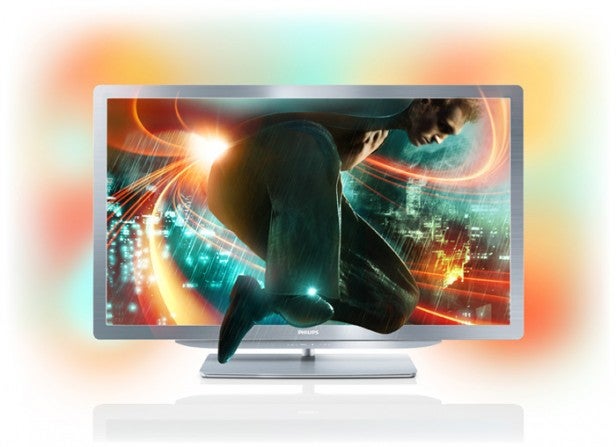
Verdict
Pros
- Stunning 2D pictures
- Moth-eye filter is awesome
- Beautifully designed and built
Cons
- Crosstalk with 3D
- It's expensive for a 46in TV
- Care must be taken with TV's processing settings
Key Specifications
- Review Price: £2299.00
- 46in LCD TV with direct LED backlighting
- Active 3D TV
- Ambilight
- Perfect Pixel HD processing
- Smart TV functionality
- Moth Eye filter technology
Up till now, we’ve never been fans of moths. In fact, we’ve tended to
find their general night-time flutteriness rather annoying. Today,
though, the little critters have gone way up in our estimation. For it
turns out that for all the millennia they’ve been around, the cheeky
little chaps have been sitting on a secret that has the potential to
revolutionise TV technology.
You see, to help them avoid detection in the
dark, moths have developed eyes featuring tiny filtering nodules that
help them become ultra-efficient absorbers of light. And it’s occurred
to some clever bod at Philips that if you could replicate this
moth-eye design on a TV, the impact on its contrast performance could be
extreme.
The currently unique result of this innovative
thinking is the Philips 46PFL9706: a 46in TV that’s been causing
shockwaves with its picture quality at every technology show it’s
appeared at for the past few months. 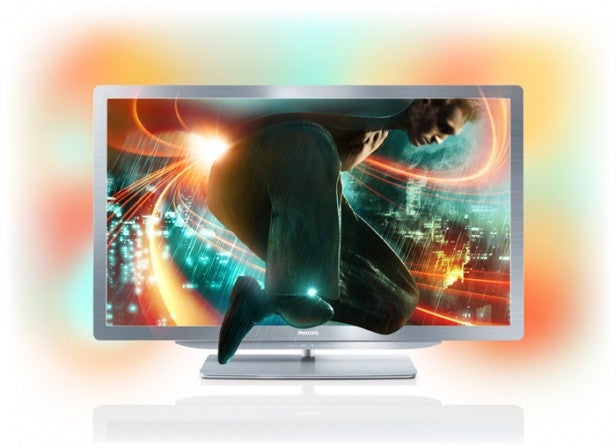
Hard
experience has shown on more than one occasion, though, that what can
look giddily brilliant on a crowded, bright show floor doesn’t always
translate to a domestic/test environment. So today, now that we’ve
finally (months later than expected) got a 46PFL9706 in our sweaty
palms, the simple question is: is it really as good as we hope it is?
Before
answering that question, though, we should point out that sweaty palms
really aren’t a good idea when handling the 46PFL9706. For the moth-eye
filter hates being touched, to the point where any finger or palm
contact makes so much mess that it will have to be dealt with by the
application of some special cleaning fluid that Philips supplies with
the TV.
Fear of damaging the apparently delicate filter made the
fiddly business of attaching the 46PFL9706 to its stand pretty
terrifying. On the upside, the TV looks very handsome indeed once you’ve
got it built, thanks especially to the glinting, touchable (or not) quality of
its metallic finish. The stand, in particular, is gorgeous, apparently
hewn from a single block of solid, brushed aluminium.
The stand
is more than just a pretty face too. For unusually it also holds the
TV’s speakers, with audio information shipped in via a short cable
connected to the TV’s rear. This obviously raises the question of what
you do if you want to wall hang your 46PFL9706. And the answer is that the stand fixes flat on the wall and becomes the mount for the TV, with its audio reproduction being adjusted via an onscreen menu. Neat. Except that the beautifully built stand is no longer visible, of course.
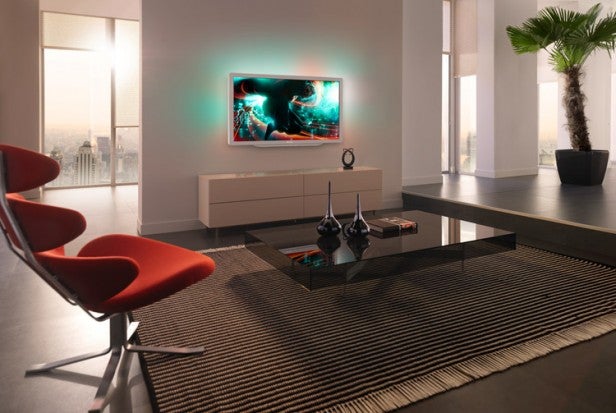
The
rear sides and top of the TV are equipped with rows of LED lights,
there to deliver Philips’ Ambilight technology from three of the TV’s
edges. This works by throwing coloured light from the TV that can be set
to correlate – to a surprisingly local and tonally accurate degree –
with the colour content of the image being shown. The result is more
immersion in what you’re watching, and less eye fatigue.
The
46PFL9706’s only design issue is that it’s not the slimmest TV in town.
But there’s a good reason for this, namely that it employs direct LED
lighting, where clusters of LEDs sit directly behind the screen. The key
advantage of this approach is that it allows you to control the
brightness level of pretty localised sections of the picture, with
potentially huge contrast advantages. Especially when, as in the
46PFL9706’s case, the local brightness control is applied to a mammoth
224 separate LED ‘sections’.
The 46PFL9706’s flagship status is
further underlined by its comprehensive ‘smart TV’ functionality, its
full HD active 3D support, and its carriage of Philips’ most powerful
video processing system ever.
The Smart TV stuff centers around a combination of video, music and
photo playback – across a comprehensive range of file formats – from USB
storage devices; playback of similar file types through a networked
DLNA-capable PC; recording from the built-in Freeview HD tuner to USB
HDDs; and access to Philips’ NetTV online platform. Both the DLNA and
online features can be accessed via integrated wi-fi.
NetTV has
grown from last year’s offering, with the most key addition being the
BBC iPlayer. The full service list now looks like this: YouTube, the BBC
iPlayer; MeteoConsult; facebook; Aupeo Personal Radio; HiT
Entertainment; CNBC Real Time; TuneIn Radio; iConcerts; Twitter;
Viewster; Euronews; Vimeo; the Picasa photo storage site; Meteonews; Box
Office 365; Cartoon Network; France 24 On Demand; TV5 Monde; The
FunSpot gaming network; DailyMotion; ScreenDreams; CineTrailer; TomTom
HD Traffic; the Foreca weather forecaster; Tunin.FM digital radio; ebay;
TED Talks; the Films and Stars network; the MyAlbum photo storage site;
a Volkswagen promotional site; and the cloud-based AceTrax movie
purchase/rental service.
Long though this list may seem, the
number of options is actually still lower than that found on Smart TVs
from Sony and especially Samsung and LG right now. But Philips
undoubtedly has more content deals ‘waiting in the wings’.
If
you’re paying attention you’ll have noticed that we mentioned a Freeview
HD tuner back there. For thankfully Philips has included these tuners
in all its key TVs this year, putting right its 2010 faux pas.
The
active 3D system carried on the 46PFL9706 is supported by a built-in
transmitter and two free pairs of Philips’ new light and comfortable 3D
glasses. These glasses also carry a ‘player 1/2’ switch because, rather
coolly, the 46PFL9706 can convert a split-screen two-player game into
two simultaneous 2D full-screen views by sending one ‘screen’ through
the left-eye data stream and the other through the ‘right eye’ data
stream.
The new Perfect Pixel HD picture processing is
apparently twice as powerful as its already fearsomely specified
predecessor – a fact that should lead to more precise, less artefacty
picture enhancements with 2D material and, for the first time from
Philips, motion processing with 3D footage.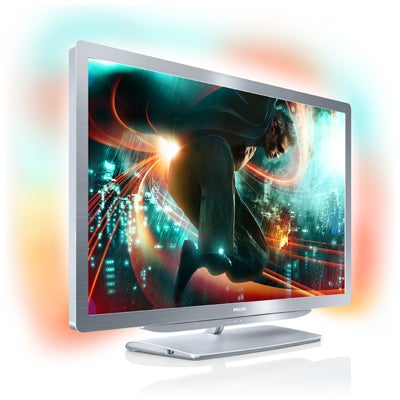
Almost
all aspects of the 46PFL9706’s processing engine are adjustable via the
well-presented onscreen menus. And you really should familiarise
yourself with the effects of most of these processing settings if you’re
to know when and when not to use them. Certainly the Perfect Natural
Motion system, sharpness boosting circuitry and noise reduction options
in particular should generally be avoided with Blu-ray material.
The
46PFL9706 is the first Philips TV to be endorsed by the Imaging Science
Foundation (ISF), and as such it offers a plentiful array of
calibration tools. Bagging ISF support should help Philips win over a
few more AV purists, too, who tend to be suspicious of the brand’s
penchant for heavy-duty video processing.
All this, and we
haven’t even talked about the 46PFL9706’s performance yet. Just as well,
then, that where 2D is concerned it can be summed up in one word:
awesome.
Getting into more detail, the set’s black level response
is astonishing, setting not only new standards for LCD technology but
even getting a little deeper than the final range of commercially
released Pioneer Kuro plasmas. Honestly, it’s that good.
The
moth-eye filter, meanwhile, does such an astonishingly good job of
suppressing light reflections from your room that you almost forget
there’s a screen on the TV at all; it’s more like you’re just looking
straight at a world inside the TV. The impact this almost eery effect
has on dark scenes, in particular, is truly remarkable. It also makes
the 46PFL9706 uniquely great for use in a bright room.
The
46PFL9706’s use of direct LED lighting with local dimming, meanwhile,
ensures that it delivers outstandingly bright whites and vibrantly
saturated colours right alongside the sort of inky blacks described a
moment ago, giving images a stunning appearance of contrast (the set’s
contrast ratio is quoted at 150,000,000:1!).
The 46PFL9706’s outrageous contrast performance also helps it deliver
wonderfully potent, vibrant colours. Yet the screen’s innate quality is
such that even the most aggressive of tones still contains immaculate
subtlety when it comes to blends and tonal shifts. The full range of
colours the screen can produce is also jaw-dropping.
Philips’
high-end TVs have long delivered A-List levels of sharpness, and the
46PFL9706 continues that theme. In fact, thanks to the intensity of the
set’s contrast range, sharpness and detailing if anything seems even
more pronounced with HD sources than it has been on previous Philips
generations. What’s more, this gorgeous clarity is achieved without the
‘assistance’ of the set’s sharpness processing.
Similarly, the
sharpness holds up impressively well when the screen has lots of motion
to cope with without needing the Perfect Natural Motion processing. This
does remove judder remarkably well, we guess, and so you might find it
useful with some TV broadcasts. But crucially if you don’t like it, you
don’t need it.
With 2D, the 46PFL9706 sails scarily close to
that elusive beast named perfection. Yes, as usual you have to be
careful with the TV’s processing tools. But actually, many of these
tools deliver their goods without causing anything like the unwanted
side effects noted on previous Philips sets.
Probably the only
genuine complaint that can be raised against the 46PFL9706’s 2D
pictures is that even though there are 224 separate dimming ‘zones’, you
can still occasionally see a little brightness ‘haloing’ around bright
image elements, especially if they appear against dark backgrounds and
you’re watching the set from an angle. From a ‘straight on’ position,
though, even at its worst this haloing problem is really very subtle and
pretty controllable via the set’s backlight and brightness controls.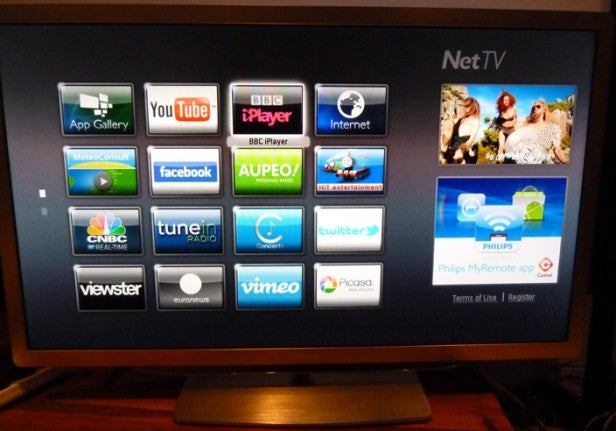
In
some ways the 46PFL9706’s 2D strengths serve it well in 3D mode too.
Certainly the screen’s colour intensity and high level of contrast and
brightness help counter the dimming effect of the shuttering 3D glasses.
You can also clearly see all the HD resolution that’s part of the
active 3D experience, and the option to apply Perfect Natural Motion in
3D mode is an impressive if not always natural-looking sight.
There’s
also plenty of depth to 3D images using the default ‘normal’ depth
setting (though you can actually adjust the depth to ‘lower’ or ‘higher’
using a special setting in the onscreen menus).
There is,
however, a catch. For you don’t have to look hard to see that the
46PFL9706 suffers with crosstalk. This double ghosting noise crops up
both more regularly and more obviously than we’d like, especially during
dark scenes. This is unexpected considering that Philips claims to have
really worked on reducing the problem. But running the 46PFL9706
alongside a Panasonic P46GT30, there’s simply no denying that crosstalk
is far more prevalent on the Philips model.
Thankfully, there is a
built-in solution of sorts. Namely that if you reduce the 3D image’s
depth, the crosstalk vanishes – almost completely. Ace. Or it would be
if the ‘lower’ 3D depth setting didn’t look more like 2D for some of the
time…
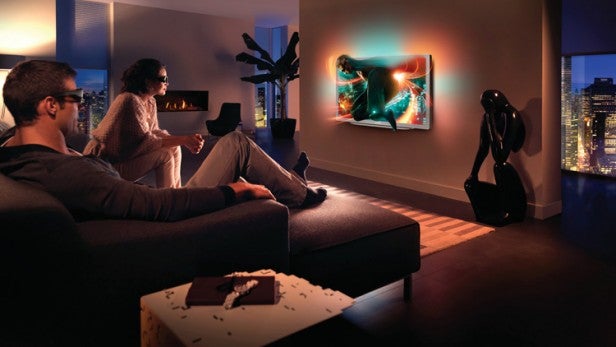
Serious gamers, meanwhile, will be pleased
to learn that we managed to get the TV’s input lag down to just 30ms – a very respectable result for such a processing-heavy TV. This figure was only obtained on a second test sample, after the first returned a figure of nearly 80ms. But Philips assures us that this lower figure is what we should be seeing, and it makes sense with what we know of the panel’s heritage. Just note that it’s critical that you both choose the Game mode and then turn off ALL further processing (noise reduction, Perfect Contrast, Perfect Colour etc) in order to get the lag levels down to the 30ms level.
Quite why Philips should choose to leave any processing elements on even after you’ve chosen game mode, requiring you to manually turn them off, is anyone’s guess.
The last
thing to cover with Philips’ mostly amazing new box of tricks is sound
quality. And contrary to expectations, the speakers in the stand are
actually quite good, delivering high levels of bass as well as a fairly
open mid-range and plenty of volume before things start to sound muddy.
Philips’ previous 9000 series sounded better, from what we remember, but
the 46PFL9706’s audio is still well above average.
Verdict
For
a good deal of the time, the 46PFL9706 is nothing short of stunning.
In fact, when calibrated sensibly the 46PFL9706’s 2D pictures are as
close to perfect as we’ve seen this year, even outperforming the images
of Panasonic’s plasmas in some key ways.
The set isn’t as easy to
recommend to 3D fans, alas. But if 2D is what
you’re most interested in, the 46PFL9706 really is the current state of
the art. Moths, we salute you.
How we test televisions
We test every TV we review thoroughly over an extended period of time. We use industry standard tests to compare features properly. We’ll always tell you what we find. We never, ever, accept money to review a product.
Trusted Score
Score in detail
-
Features 10
-
3D Quality 8
-
Value 8
-
Design 10
-
2D Quality 10
-
Sound Quality 8
Features
| Size (Inch) | 46in |
| Display Type | LED |
| Max. Resolution | 1920 x 1080 |
| Full HD 1080p | Yes |
| Digital Tuner | Yes |
| Freeview HD | Yes |
| Freesat HD | No |
| 3D Ready | Yes |
| Contrast Ratio | 50,000,000:1 |
| Refresh Rate (Hertz) | 1200Hz |
Connectivity
| HDMI | 4 |
| Component | 1 |
| Composite | 1 |
| Scart | 1 (RGB) |
| Digital Audio Out | 1 (optical) |
| Headphone | 1 |
| Charging/Computer Connection | 2 |
| Ethernet | Yes |
| WiFi | Yes (built-in) |
Physical Specifications
| Height (Millimeter) | 660mm |
| Width (Millimeter) | 1083mm |
| Depth (Millimeter) | 39mm |
| Weight (Gram) | 1600g |

